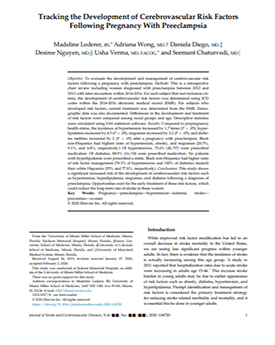Preeclampsia Correlated with Development of Stroke
In a retrospective study conducted by a group of researchers led by Seemant Chaturvedi, MD, University of Maryland School of Medicine Stewart J. Greenebaum Endowed Professor of Stroke Neurology and Director of the University of Maryland Medical System's Stroke Program, women who were diagnosed with preeclampsia during pregnancy were significantly more likely to exhibit risk factors for stroke in the years shortly thereafter1.
Through a chart review, Dr. Chaturvedi and his research colleagues discovered that among 183 women who developed preeclampsia in 2012 or 2013, incidence of hypertension, diabetes mellitus, migraines and hyperlipidemia increased 1.7 to 4.5 times when measured from 2014 to 2016.
| Risk Factor | Increase in Incidence Pre-pregnancy v. Post-preeclampsia | P Valve |
| Hypertension | 1.7 times | < .05 |
| Diabetes mellitus | 2 times | < .05 |
| Migraines | 2.2 times | < .05 |
| Hyperlipidemia | 4.5 times | < .05 |
The study’s authors recommend that primary care physicians and OB-GYNs monitor patients with preeclampsia history for cerebrovascular risk factors and medically manage these risk conditions to prevent future ischemic events.
Incidence of Stroke Rising Among Younger Adults Even as Overall Stroke Mortality Declines in U.S.
The study authors mention that hospitalizations among patients aged 15 to 44 for acute ischemic stroke is rising, likely attributable to growing prevalence of cerebrovascular risk factors such as obesity, diabetes, hypertension and high cholesterol in increasingly younger populations. For many women, pregnancy can serve as a “natural stress test.” About 5% to 8% of pregnant women develop preeclampsia – characterized by hypertension plus either proteinuria or end organ damage in the latter half of pregnancy – a condition thought by some experts to be the same disease process as cerebrovascular and cardiovascular diseases. Primary care providers should realize that younger patients face a real threat for cerebrovascular events in the presence of such risk factors, and preeclampsia is an early warning sign.
Managing Cerebrovascular Risk Factors After the Emergence of Preeclampsia
Despite the strong connection of preeclampsia with certain risk factors for stroke, the authors mentioned that recent data suggest that only 9% of internists and 38% of OB-GYNs counsel their patients who had preeclampsia about how to reduce their risk for vascular diseases2. However, through a review of electronic health records, Dr. Chaturvedi and his fellow researchers also had the opportunity to study how well patients with a history of preeclampsia received medical management for cerebrovascular risk factors. Patients ranged in age from 19 to 48, averaging 32.3 years, and while none with hyperlipidemia were put on statins, 73.6% of patients received medical management for hypertension, as did 88.9% for diabetes.
Moreover, the patient population under investigation was an urban one, comprising 48% black non-Hispanic patients and 35% white Hispanic patients. While insurance status was not statistically significant as to whether risk factors were medically managed (P = .68), racial group appeared to make a difference. For patients with hypertension, 74.3% of black non-Hispanics received medical treatment with an antihypertensive, while 55% of white Hispanics with hypertension did. When patients had diabetes, 100% of black non-Hispanics were prescribed medication compared to 77.8% of white Hispanics.
Early Intervention & Preventive Care Are Crucial
While the study authors pointed out a couple caveats – risk factors for stroke increase with age regardless, and there was potential selection bias to the study group because patients seeking subsequent care might be less healthy than those who did not – these have no bearing on the study’s revelation of the need to better ensure that patients from all racial groups receive appropriate medical management for cerebrovascular risk factors. The authors conclude that if providers apply a more systematic approach to surveilling for and managing these risk factors among patients who develop preeclampsia, more strokes can be prevented.
1Lederer M, Wong A, Diego D, Nguyen D, Verma U, Chaturvedi S. Tracking the development of cerebrovascular risk factors following pregnancy with preeclampsia. J Stroke Cerebrovas Dis. In press. doi: 10.1016/j.jstrokecerebrovasdis.2020.104720
2Aye CYL, Elmahi E, Boardman H, et al. Do young women need treatment for hypertension after pregnancy complications? J Am Heart Assoc. 2018;7.
Related Content
- View the Tracking the Development of Cerebrovascular Risk Factors Following Pregnancy With Preeclampsia article
- Learn more about the University of Maryland Medical Center's Comprehensive Stroke Center
- View Dr. Chaturvedi’s publications on PubMed
- Read more about neurology services at the University of Maryland Medical Center

